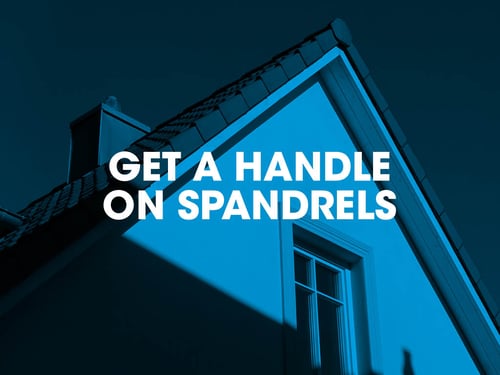Design requirements of gable-end spandrel panels
Using spandrel panels as the gable construction in a timber frame building, or as a continuation of the internal skin of a masonry cavity wall, means the panels must be designed to resist wind loadings acting on the end walls as well as loads applied by the claddings. Spandrel panels should be suitably designed to transmit the loads to the roof structure via lateral restraints and vertically down to the inner leaf blockwork or timber frame.
Gable spandrel panels should incorporate a sheathing board and breather membrane and maintain a minimum 50mm clear cavity, full fill cavity wall insulation is not acceptable for warranty in these situations. The stud positions should also be clearly marked on the breather membrane so that wall ties can be correctly installed.
Spandrel panels must be designed on a site-by-site basis by a suitably qualified structural engineer. A full design with structural calculations must be provided that includes the points listed below. You should be aware that some of this information may not be provided by the truss roof manufacturer or timber frame panel manufacturer.
The required spandrel panel design inclusions are:
- A site-specific wind analysis stating the worst-case elevational pressure and suction measured in kN/m2
- A panel design statement of the timber grade, stud size and centres.
- A design philosophy confirming at which levels lateral restraints/support is taken and details of the type and fixings of restraint
- A full set of structural engineer’s calculations to take the supporting reactions and note where they are applied to the main structure
- A design statement from the project engineer stating they have taken account of the support reactions and included them in the design of any supporting elements
- The fire requirements for each project (boundary and height) specified by the designer/ architect to suit the requirements of each project to comply with Building Regulations
Spandrel Panel Construction Considerations
In masonry cavity wall construction situations, the following provisions should be applied in accordance with the structural engineer’s design:
- Provision for restraint of the top of the internal masonry wall where it meets the spandrel panel should be provided. Lateral restraint straps should not be faced fixed without a structural engineer’s design.
- Fixing of the base of the spandrel panel to the masonry.
- Lateral restraint of the spandrel panel back to the roof structure (including fixing location and type).
In both masonry and timber frame construction,
- a minimum 50mm clear cavity between the spandrel panel and the external masonry leaf should be maintained.
- Ensure that provision for lateral restraint of the spandrel panel back to the roof structure (including fixing location and type) is in accordance with the structural engineer’s design.
- Intermediate restraint may also be necessary for larger panels.
More detailed information about gable wall and roof construction can be found in Chapter 7 of the LABC Warranty Technical Manual.
Spandrel Panels and Cavity Trays
You must ensure that where a cavity tray is incorporated at the base of the spandrel, the spandrel panel is ventilated and the cavity tray drained by full height perp vents above the cavity tray at 900mm centres, with suitable stop ends provided.
In a masonry cavity wall construction where blown full fill insulation is being used below the spandrel panel location, a cavity tray should be provided. Take care to ensure the insulation does not deform the cavity tray or spread into the spandrel panel cavity frame area. A non-deformable cavity closure or ridged preformed cavity tray should be used.
In addition, consideration should be given to ensuring the stability of the masonry wall external leaf above where a slip plane is introduced e.g. by a cavity tray.
Finally, any cavity trays should be lapped by the breather membrane to a minimum of 100mm.
Further important notes to consider
- The wall tie spacing should be fixed through to the vertical studs of the panel (not the sheathing panels) at centres specified in the structural engineer’s design
- Suitable timber frame wall ties should be used to tie the external skin of masonry to the spandrel panel
- A breather membrane should always be incorporated on the cavity side of the spandrel panel
- A drained and ventilated cavity needs to be maintained with a minimum 50mm clear cavity between the spandrel panel and the external masonry leaf
- A condensation risk analysis should be provided where fire resistance requirements or internal panel lining mean that the roof insulation cannot be continued into the panel

